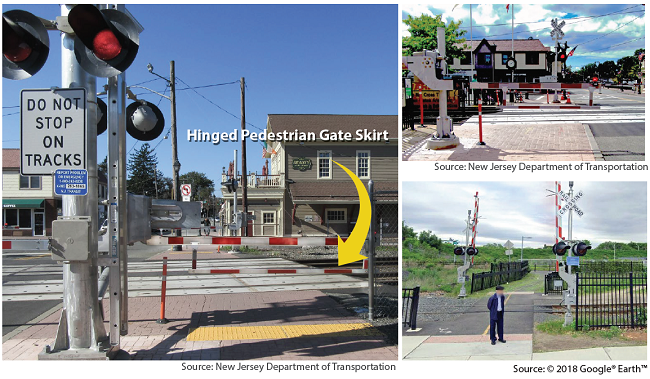NOTEWORTHY PRACTICE
Improving Pedestrian Rail-Crossing Safety with Hinged Pedestrian Gate Skirts


FHWA-SA-19-037

"Only cross railroad tracks at designated pedestrian and roadway crossings."
"Do not attempt to cross a railroad if red lights are flashing."
"Never walk around or under lowered gates at a crossing."
HINGED PEDESTRIAN GATE SKIRT EXAMPLE

Source: FHWA
PEDESTRIAN GATE SKIRT PILOT PROJECT

Source: USDOT FRA, Effect of Gate Skirts on Pedestrian Behavior at a Highway-Rail Grade Crossing Final Report, 2013.
While these safety messages and tips are integral to improving overall railroad safety, hinged pedestrian gate skirts are physical structures that can help further improve pedestrian safety at rail crossings.1 A hinged pedestrian gate skirt is a secondary horizontal bar that hangs under an existing pedestrian gate. This treatment deters pedestrians from going under a gate that is in movement and in the down position. The low position of the gate skirt also benefits people who are blind or have low vision because the gate can be detected using canes or other mobility aids. Both Connecticut and New Jersey have installed hinged pedestrian gate skirts to better block access to crossings, deterring pedestrian violations.
Connecticut

Source: © 2018 Google® Earth™
When new roadway construction and land use changes occurred in New Britain, Connecticut, the Connecticut Department of Transportation (CTDOT) converted an existing highway-railroad crossing to a pedestrian- and bicycle-only crossing. The new railroad crossing design needed to safely accommodate pedestrians and bicyclists accessing a nearby busway station, multi-use trail, and other amenities.
CTDOT and its railroad partners worked together to develop the new crossing design, which featured a hinged pedestrian gate skirt. Fencing, emergency exit gates, and video monitoring were also included in the design to optimize safety. The project was completed in June 2016.
CTDOT was the first State to install a hinged pedestrian gate skirt.
As the first State to install a hinged pedestrian gate skirt, Connecticut has found the crossing treatment an effective safety tool. CTDOT intends to install a similar hinged gate skirt system in the Branchville section of Ridgefield, Connecticut, at a Metro-North Railroad crossing where vehicle access will be modified to pedestrian/bicyclist-only access.2
In 2017, NJDOT became the second State.
New Jersey

Source: New Jersey Department of Transportation
In 2016, three pedestrians were hit and killed near the Main Street and Ramsey transit station in Ramsey, New Jersey. The New Jersey Department of Transportation (NJDOT), New Jersey Transit, Federal Railroad Administration (FRA), and local town officials worked together to find and implement a treatment to help prevent similar tragedies from occurring again. The team determined that installing a hinged pedestrian gate skirt was an effective solution for the crossing.
"The New Jersey Department of Transportation and New Jersey Transit are committed to improving safety at rail crossings. These hinged gates have proven effective and provide another option to improve safety."
Steve Schapiro, Deputy Director of Communications, NJDOT
In the summer of 2017, NJDOT became the second State in the country to install a hinged pedestrian gate skirt. As part of the project, NJDOT also added fencing, signs, and pavement markings to increase safety and improve general awareness near the crossing. According to NJDOT, the number of violations have decreased at the location, and most importantly, no fatalities have occurred since the installation of the hinged pedestrian gate skirt.3
1 The hinged pedestrian gate skirt is under consideration to be included in a future edition of the Manual on Uniform Traffic Control Devices. [ Return to note 1. ]
2 Stephen Curley (Connecticut Department of Transportation), phone interview, October 23, 2019. [ Return to note 2. ]
3 Steve Schapiro and Todd Hirt (New Jersey Department of Transportation), phone interview, October 2, 2019. [ Return to note 3. ]
Page last modified on May 12, 2020
